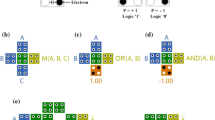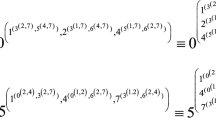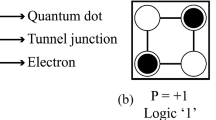Abstract
Efficient utilization of the inherent parallelism of multi-core architectures is a grand challenge in the field of electronic design automation (EDA). One EDA algorithm associated with a high computational cost is automatic test pattern generation (ATPG). We present the ATPG tool TIGUAN based on a thread-parallel SAT solver. Due to a tight integration of the SAT engine into the ATPG algorithm and a carefully chosen mix of various optimization techniques, multi-million-gate industrial circuits are handled without aborts. TIGUAN supports both conventional single-stuck-at faults and sophisticated conditional multiple stuck-at faults which allows to generate patterns for non-standard fault models. We demonstrate how TIGUAN can be combined with conventional structural ATPG to extract full benefit of the intrinsic strengths of both approaches.
Similar content being viewed by others
References
Abramovici M., Breuer M.A., Friedman A.D.: Digital Systems Testing and Testable Design. Computer Science Press, New York (1990)
Aitken, R.C.: New defect behavior at 130 nm and beyond. In: European Test Symposium, pp. 279–284 (2004)
Ayari B., Kaminska B.: A new dynamic test vector compaction for automatic test pattern generation. IEEE Trans. CAD 13(3), 353–358 (1994)
Brglez, F., Bryan, D., Kozminski, K.: Combinational profiles of sequential benchmark circuits. In: International Symposium on Circuits and Systems, pp. 1929–1934 (1989)
Brglez, F., Fujiwara, H.: A neutral netlist of 10 combinational circuits and a target translator in fortran. In: International Symposium on Circuits and Systems, Special Sess. on ATPG and Fault Simulation, pp. 663–698 (1985)
Cho, K.Y., Mitra, S., McCluskey, E.J.: Gate exhaustive testing. In: International Test Conference (2005)
Corno F., Sonza Reorda M., Squillero G.: RT-level ITC 99 benchmarks and first ATPG results. IEEE Des. Test Comput. 17(3), 44–53 (2000)
Davis M., Putnam H.: A computing procedure for quantification theory. J. ACM 7(3), 201–215 (1960)
Desineni, R., Dwarkanath, K.N., Blanton, R.D.: Universal test generation using fault tuples. In: International Test Conference, pp. 812–819 (2000)
Drechsler R., Eggersglüß S., Fey G., Glowatz A., Hapke F., Schlöffel J., Tille D.: On acceleration of SAT-based ATPG for industrial designs. IEEE Trans. CAD 27(7), 1329–1333 (2008)
Eggersglüß, S., Drechsler, R.: Improving test pattern compactness in SAT-based ATPG. In: Asian Test Symposium, pp. 445–452 (2007)
El-Maleh A.H., Al-Utaibi K.: An efficient test relaxation technique for synchronous sequential circuits. IEEE Trans. CAD 23(6), 933–940 (2004)
Engelke, P., Braitling, B., Polian, I., Renovell, M., Becker, B.: SUPERB: simulator utilizing parallel evaluation of resistive bridges. In: Asian Test Symposium, pp. 433–438 (2007)
Engelke P., Polian I., Renovell M., Becker B.L: Automatic test pattern generation for resistive bridging faults. J. Electron. Test. Theory Appl. 22(1), 61–69 (2006)
Engelke P., Polian I., Renovell M., Becker B.: Simulating resistive bridging and stuck-at faults. IEEE Trans. CAD 25(10), 2181–2192 (2006)
Fey, G., Warode, T., Drechsler, R.: Reusing learned information in SAT-based ATPG. In: VLSI Design, IEEE Computer Society, pp. 69–76 (2007)
Fujiwara, H.: FAN: A fanout-oriented test pattern generation algorithm. In: IEEE International Symposium on Circuits and Systems, pp. 671–674 (1985)
Fujiwara H., Inoue T.: Optimal granularity of test generation in a distributed system. IEEE Trans. CAD 9(8), 885–892 (1990)
Gizdarski E., Fujiwara H.: SPIRIT: a highly robust combinational test generation algorithm. IEEE Trans. CAD 21(12), 1446–1458 (2002)
Goel P.: An implicit enumeration algorithm to generate tests for combinational logic circuits. IEEE Trans. CAD 30, 215–222 (1981)
Hamzaoglu I., Patel J.H.: New techniques for deterministic test pattern generation. J. Electron. Test. Theory Appl. 15, 63–73 (1999)
Hamzaoglu I., Patel J.H.: Test set compaction algorithms for combinational circuits. IEEE Trans. CAD 19(8), 957–963 (2000)
Hillebrecht, S., Polian, I., Engelke, P., Becker, B., Keim, M., Cheng, W.-T.: Extraction, simulation and test generation for interconnect open defects based on enhanced aggressor-victim model. In: Internatinal Test Conference, pp 1–10 (2008)
Kajihara, S., Miyase, K.: On identifying don’t care inputs of test patterns for combinational circuits. In: Internatinal Conference on CAD, pp. 364–369 (2001)
Kajihara S., Pomeranz I., Kinoshita K., Reddy S.M.: Cost-effective generation of minimal test sets for stuck-at faults in combinational logic circuits. IEEE Trans. CAD 14(12), 1496–1504 (1995)
Kropf T.: Introduction to Formal Hardware Verification. Springer, Berlin (2000)
Kundu S., Zachariah S.T., Chang Y.-S., Tirumurti C.: On modeling crosstalk faults. IEEE Trans. CAD 24(12), 1909–1915 (2005)
Larrabee, T.:. Efficient generation of test patterns using Boolean difference. In: Internatinal Test Conference, pp. 795–801 (1989)
Lewis, M., Schubert, T., Becker, B.: Multithreaded SAT solving. In: ASPDAC 2007, Yokohama, Japan, January 2007. 12th Asia and South Pacific Design Automation Conference (2007)
Polian I., Czutro A., Kundu S., Becker B.: Power droop testing. IEEE Des. Test Comput. 24(3), 276–284 (2007)
Pomeranz, I., Reddy, L.N., Reddy, S.M.: COMPACTEST: a method to generate compact test sets for combinational circuits. In: Internatinal Test Conference, pp. 194–203 (1991)
Rajski J., Tyszer J., Kassab M., Mukherjee N.: Embedded deterministic test. IEEE Trans. CAD 23(5), 776–792 (2004)
Renovell M., Azaïs F., Bertrand Y.: Detection of defects using fault model oriented test sequences. J. Electron. Test. Theory Appl. 14, 13–22 (1999)
Roth J.P.: Diagnosis of automata failures: a calculus and a method. IBM J. Res. Dev. 10, 278–281 (1966)
Rudnick E.M., Patel J.H.: Efficient techniques for dynamic test sequence compaction. IEEE Trans. Comput. 48(3), 323–330 (1999)
Sar-Dessai, V., Walker, D.M.H.: Resistive bridge fault modeling, simulation and test generation. In: Internatinal Test Conference, pp. 596–605 (1999)
Sato, Y., Yamazaki, I., Yamanaka, H., Ikeda, T., Takakura, M.: A persistent diagnostic technique for unstable defects. In: Internatinal Test Conference, pp. 242–249 (2002)
Schubert T., Lewis M., Becker B.: PaMiraXT: Parallel SAT solving with threads and message passing. J. Satisfiability, Boolean Model. Comput. 6, 203–222 (2009)
Shinogi, T., Kanbayashi, T., Yoshikawa, T., Tsuruoka, S., Hayashi, T.: Faulty resistance sectioning technique for resistive bridging fault ATPG systems. In: Asian Test Symposium, pp. 76–81 (2001)
Siewiorek D.P., Swarz R.S.: Reliable Computer Systems—Design and Evaluation. Digital Press, Belford (1992)
Smith, G.L.: Model for delay faults based upon paths. In: International Test Conference, pp. 342–349 (1985)
Snir M., Otto S.W., Walker D.W., Dongarra J., Huss-Lederman S.: MPI: The Complete Reference. MIT Press, Cambridge (1996)
Stephan P., Brayton R., Sangiovanni-Vincentelli A.: Combinational test generation using satisfiability. IEEE Trans. CAD 15(9), 1167–1176 (1996)
Tafertshofer, P., Ganz, A.: SAT based ATPG using fast justification and propagation in the implication graph. In: Internatinal Conference on CAD, pp.139–146 (1999)
Wang, C., Reddy, S.M., Pomeranz, I., Lin, X., Rajski, J.: Conflict driven techniques for improving deterministic test pattern generation. In: Internatinal Conference on CAD (2002)
Zhang M., Mitra S., Mak T.M., Seifert N., Wang N.J., Shi Q., Kim K.S., Shanbhag N.R., Patel S.J.: Sequential element design with built-in soft error resilience. IEEE Trans. VLSI Syst. 14(12), 1368–1378 (2006)
Author information
Authors and Affiliations
Corresponding author
Rights and permissions
About this article
Cite this article
Czutro, A., Polian, I., Lewis, M. et al. Thread-Parallel Integrated Test Pattern Generator Utilizing Satisfiability Analysis. Int J Parallel Prog 38, 185–202 (2010). https://doi.org/10.1007/s10766-009-0124-7
Received:
Accepted:
Published:
Issue Date:
DOI: https://doi.org/10.1007/s10766-009-0124-7




